Surgical management of bisected iris with extensive iridodialysis
It is crucial to assess the extent of the damage intraoperatively and design the surgical repair accordingly.
 Thomas John |
Phacoemulsification has continued to advance to the forefront of ophthalmic microsurgical procedures. However, intraoperative surgical complications can occur, especially if there is sudden, unexpected movement of the patient during such delicate, fast, technology-driven ophthalmic procedures. One such potential complication is iridodialysis. When there is extensive iridodialysis, proper fixation of the iris for restoration of a relatively normal anterior segment anatomy is an essential surgical goal. Various surgical techniques have been described, including sutureless technique and nonappositional repair of iridodialysis. This becomes even more challenging for the ophthalmic surgeon confronted with a totally bisected iris.
In this column, I describe a surgical technique for the management of a bisected iris with extensive iridodialysis.
A 70-year-old Caucasian male was referred with extensive iridodialysis of his left eye that occurred due to inadvertent movement of the patient during phacoemulsification by his referring ophthalmologist.
Surgical technique
The preferred anesthesia is general anesthesia because the patient has a history of sudden movement without warning during surgery.
Before proceeding to surgical repair, it is important to assess the extent of the damage intraoperatively and design the repair accordingly. Figure 1 shows iridodialysis and an eccentric pupil. If the surgical repair were done without assessing the extent of tissue damage, it would result in suboptimal repair and permanent secondary damage. Surgical exploration revealed that the iris was completely bisected in the temporal region (Figure 2) and resulted in overlapping of the iris leaflets, creating a pseudo-ectopic pupil (Figure 1). Following conjunctival peritomy, hemostasis is achieved using a handheld disposable pencil cautery (Figure 3). The anterior chamber is filled with Viscoat (chondroitin sulfate, sodium hyaluronate, Alcon) to protect the corneal endothelium.
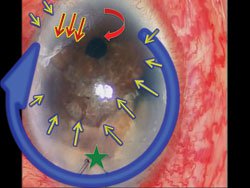 Figure 1. Patient with extensive intraoperative iris damage that occurred during phacoemulsification secondary to sudden unexpected patient movement referred for surgical management. Intraoperative temporal view of an extensive iridodialysis of about 320° (broad circular arrow), with the torn, irregular iris margin clearly visible (yellow arrows). Bisected iris diaphragm with overlapping iris leaflets (straight red arrows) creates an ectopic, pseudo-pupil (curved red arrow). The temporal clear corneal wound is visible (green star) with interrupted 10-0 nylon sutures. |
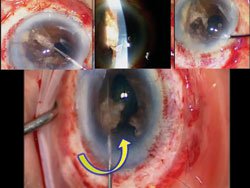 Figure 2. Intraoperative mechanical separation of the iris leaflets (insets) confirm total bisection of the iris diaphragm (yellow arrows) and the absence of a true pupil. Images: John T |
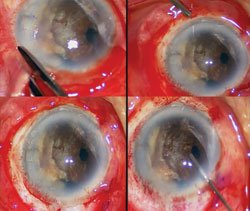 Figure 3. Conjunctival peritomy and hemostasis is achieved using a disposable cautery; viscoelastic material is injected into the anterior chamber. |
 Figure 4. Double-armed, 10-0 Prolene suture is passed from the 1 o’clock position through a peripheral clear cornea site to pass across the viscoelastic-filled anterior chamber, then through the peripheral detached iris and the limbus to exit the opposite side. Similarly, a second set of sutures is passed in a counter-clockwise direction. Additional viscoelastic is injected into the anterior chamber. |
 Figure 5. A double-armed 10-0 Prolene is then passed in the opposite direction from the 8 o’clock position to exit the limbus at the 11 o’clock position. This attaches the superonasal quadrant of the detached iris to the limbus and restores normal iris anatomy. |
 Figure 6. Additional double-armed 10-0 Prolene sutures are passed from the 8 o’clock position to exit at 2 o’clock after the needle passes through the peripheral iris, thus attaching the superotemporal quadrant of the detached iris to the limbus. Using John super-micro forceps, the iris leaflet is stretched from the inferonasal toward the inferotemporal quadrant. |
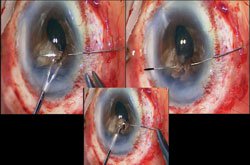 Figure 7. Needle of a 10-0 Prolene suture is passed through the clear cornea and then the first and second leaflets of the bisected iris while steadying the floppy iris leaflets using John super-micro forceps introduced through a temporal clear cornea wound; the needle finally exits the anterior chamber through the clear cornea. |
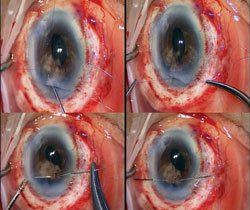 Figure 8. The sutures on either side are then pulled out of the anterior chamber using a Sinskey hook, and the suture is then tied to rejoin the bisected iris, thus creating a pupil. A second suture is similarly passed through the peripheral part of the bisected iris to complete the end-to-end reattachment of the bisected iris and exits through the clear cornea. This stabilizes the floppy detached, bisected iris. |
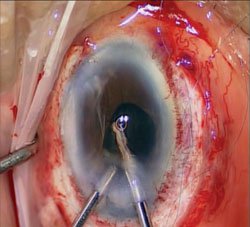 Figure 9. Bimanual anterior vitrectomy is performed to clear all vitreous and lens remnants. Notice that all the 10-0 Prolene sutures are left untied until the end of the procedure. This permits final suture adjustments for proper iris alignment and recreating the normal anatomy of the anterior segment. |
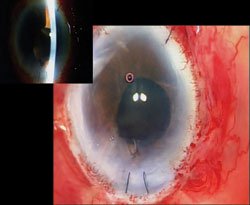 Figure 10. Normal iris anatomy is restored with resuspension of the detached iris, re-anastomosis of the bisected iris and recreation of the pupil. |
The inferonasal quadrant iris is first attached to the limbus (Figure 4). A double-armed, 10-0 Prolene suture is passed from the 1 o’clock position through a peripheral clear cornea site to pass across the viscoelastic-filled anterior chamber, then through the peripheral detached iris and the limbus to exit at the opposite side (Figure 4, top row). Similarly, a second set of sutures are passed in a counter-clockwise direction (Figure 4, bottom left), and additional viscoelastic is injected into the anterior chamber. These sutures attach the inferior iris to the limbus. Next, a double-armed 10-0 Prolene suture is passed in the opposite direction from the 8 o’clock position to exit the limbus at the 11 o’clock position (Figure 5). This attaches the superonasal quadrant of the detached iris to the limbus and restores normal iris anatomy. Additional double-armed 10-0 Prolene sutures are passed from the 8 o’clock position to exit at the 2 o’clock position after the needle passes through the peripheral iris, thus attaching the superotemporal quadrant of the detached iris to the limbus (Figure 6). Using John super-micro forceps (ASICO), the iris leaflet is then stretched from the inferonasal toward the inferotemporal quadrant.
Having attached the peripheral detached iris to the limbus, attention is directed to the bisected iris leaflets. The needle of a 10-0 Prolene suture is passed through the clear cornea and then through the first and second leaflets of the bisected iris while steadying the floppy iris leaflets using John super-micro forceps introduced through a temporal clear cornea wound; the needle finally exits the anterior chamber through the clear cornea (Figure 7). The sutures on either side are then pulled out of the anterior chamber using a Sinskey hook, and the suture is then tied to rejoin the bisected iris, thus creating a pupil (Figure 8). A second suture is similarly passed through the peripheral part of the bisected iris to complete the end-to-end reattachment of the bisected iris and exits through the clear cornea (Figure 8). This stabilizes the floppy detached, bisected iris. At this time, using a bimanual technique, an anterior vitrectomy is performed and all the remaining lens remnants are removed using the Alcon Ocutome unit (Figure 9). All the 10-0 Prolene sutures are tied. Figure 10 shows the completed view of the procedure, namely, restoration of the normal iris and anterior segment anatomy, with resuspension of the detached iris, re-anastomosis of the bisected iris and recreation of the pupil. The conjunctiva is then closed to cover the limbal 10-0 Prolene sutures (Figure 10).
Surgical pearls
1. Type of anesthesia is dependent on the surgeon. However, because we know that patient movement in part contributed to the iris damage during the first surgery, it is better to consider general anesthesia for the iris repair.
2. It is important to assess the extent of the tissue damage before any reconstructive procedure is carried out. In this case, if this step were omitted, then the pseudo-pupil would have been taken as the true pupil, which would have resulted in suboptimal repair.
3. It is important to sequentially fill the anterior chamber with viscoelastic such as Viscoat to protect the endothelium and keep any vitreous pushed posteriorly away from the reconstructive procedure site.
4. Attach the iris circumferentially with the 10-0 Prolene sutures, but do not tie the sutures until the end so that any final surgical adjustments to get the best iris alignment to the limbus are possible.
5. Hold the bisected floppy iris with a second instrument and only then pass the needle through the iris. Because the bisected iris is very floppy, it is important to steady the iris before it is sutured together.
6. Remove the vitreous and lens remnants only after the iris diaphragm is re-created, such that the ends of the bisected iris are not inadvertently cut and damaged by the Ocutome.
7. Use intraoperative slit-lamp if available to evaluate proper iris reconstruction (Figure 10).
References:
- Bardak Y, Ozerturk Y, Durmus M, Mensiz E, Aytuluner E. Closed chamber iridodialysis repair using a needle with a distal hole. J Cataract Refract Surg. 2000;26(2):173-176.
- Erakgun T, Kaskaloglu M, Kayikcioglu O. A simple closed chamber technique for repair of traumatic iridodialysis in phakic eyes. Ophthalmic Surg Lasers. 2001;32(1):83-85.
- Newell FW. Extensive traumatic iridodialysis with repair. Am J Ophthalmol. 1947;30(6):695-697.
- Richards JC, Kennedy CJ. Sutureless technique for repair of traumatic iridodialysis. Ophthalmic Surg Lasers Imaging. 2006;37(6):508-510.
- Snyder ME, Lindsell LB. Nonappositional repair of iridodialysis. J Cataract Refract Surg. 2011;37(4):625-628.
- Wachler BB, Krueger RR. Double-armed McCannell suture for repair of traumatic iridodialysis. Am J Ophthalmol. 1996;122(1):109-110.
- Thomas John, MD, is a clinical associate professor at Loyola University at Chicago and is in private practice in Oak Brook, Tinley Park and Oak Lawn, Ill. He can be reached at 708-429-2223; email: tjcornea@gmail.com.
- Disclosure: Dr. John receives a small royalty from ASICO.

